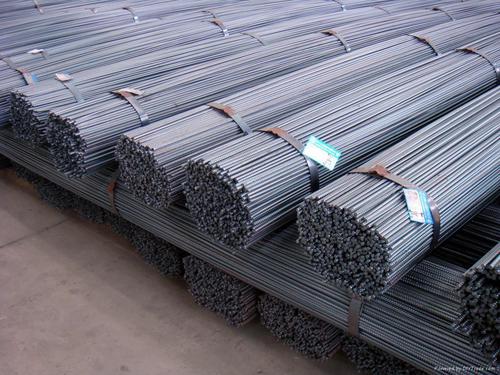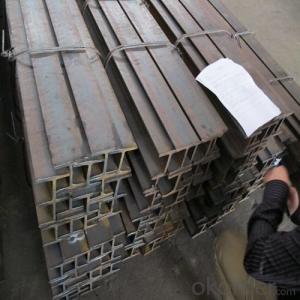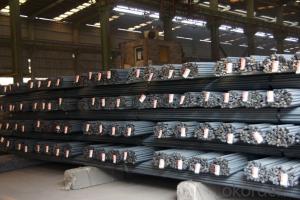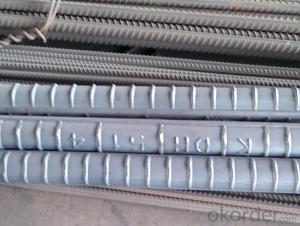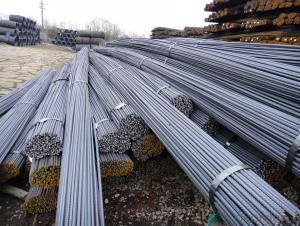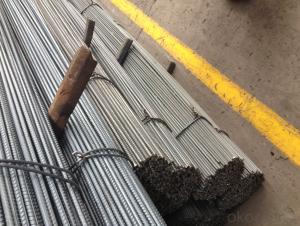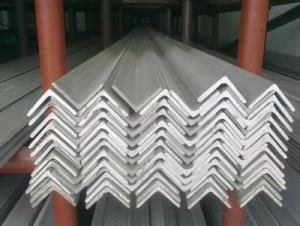Deformed bars Hot Rolled with Material GB HRB400
- Loading Port:
- Tianjin
- Payment Terms:
- TT OR LC
- Min Order Qty:
- 25 m.t.
- Supply Capability:
- 10000 m.t./month
OKorder Service Pledge
OKorder Financial Service
You Might Also Like
Product Description:
OKorder is offering high quality Hot Rolled Rebars at great prices with worldwide shipping. Our supplier is a world-class manufacturer of steel, with our products utilized the world over. OKorder annually supplies products to European, North American and Asian markets. We provide quotations within 24 hours of receiving an inquiry and guarantee competitive prices.
Product Applications:
Deformed bar is widely used in buildings, bridges, roads and other engineering construction. Big to highways, railways, bridges, culverts, tunnels, public facilities such as flood control, dam, small to housing construction, beam, column, wall and the foundation of the plate, deformed bar is an integral structure material. With the development of world economy and the vigorous development of infrastructure construction, real estate, the demand for deformed bar will be larger and larger..
Label: to be specified by customer, generally, each bundle has 1-2 labels
Product Advantages:
OKorder's Hot Rolled Rebars are durable, strong, and resist corrosion.
Main Product Features:
· Premium quality
· Prompt delivery & seaworthy packing (30 days after receiving deposit)
· Corrosion resistance
· Can be recycled and reused
· Mill test certification
· Professional Service
· Competitive pricing
Product Specifications:
Manufacture: Hot rolled
Grade: HRB400 – HRB500
Certificates: ISO, SGS, BV, CIQ
Length: 6m – 12m, as per customer request
Packaging: Export packing, nude packing, bundled
Grade | Technical data of the original chemical composition (%) | ||||||
C | Mn | Si | S | P | V | ||
HRB400 | ≤0.25 | ≤1.60 | ≤0.80 | ≤0.045 | ≤0.045 | 0.04-0.12 | |
Physical capability | |||||||
Yield Strength (N/cm²) | Tensile Strength (N/cm²) | Elongation (%) | |||||
≥400 | ≥570 | ≥14 | |||||
Theoretical weight and section area of each diameter as below for your information:
Diameter(mm) | Section area (mm²) | Mass(kg/m) | Weight of 12m bar(kg) |
6 | 28.27 | 0.222 | 2.664 |
8 | 50.27 | 0.395 | 4.74 |
10 | 78.54 | 0.617 | 7.404 |
12 | 113.1 | 0.888 | 10.656 |
14 | 153.9 | 1.21 | 14.52 |
16 | 201.1 | 1.58 | 18.96 |
18 | 254.5 | 2.00 | 24 |
20 | 314.2 | 2.47 | 29.64 |
22 | 380.1 | 2.98 | 35.76 |
25 | 490.9 | 3.85 | 46.2 |
28 | 615.8 | 4.83 | 57.96 |
32 | 804.2 | 6.31 | 75.72 |
36 | 1018 | 7.99 | 98.88 |
40 | 1257 | 9.87 | 118.44 |
50 | 1964 | 15.42 | 185.04 |
FAQ:
Q1: Why buy Materials & Equipment from OKorder.com?
A1: All products offered byOKorder.com are carefully selected from China's most reliable manufacturing enterprises. Through its ISO certifications, OKorder.com adheres to the highest standards and a commitment to supply chain safety and customer satisfaction.
Q2: Can stainless steel rust?
A2: Stainless does not "rust" as you think of regular steel rusting with a red oxide on the surface that flakes off. If you see red rust it is probably due to some iron particles that have contaminated the surface of the stainless steel and it is these iron particles that are rusting. Look at the source of the rusting and see if you can remove it from the surface.
Q3: What is the normal tolerance of Hot Rolled Mild Steel Angle Beams for Structures and for Buildings?
A3: Normally 3%-5%, but we can also produce the goods according to the customers' requests.
Images
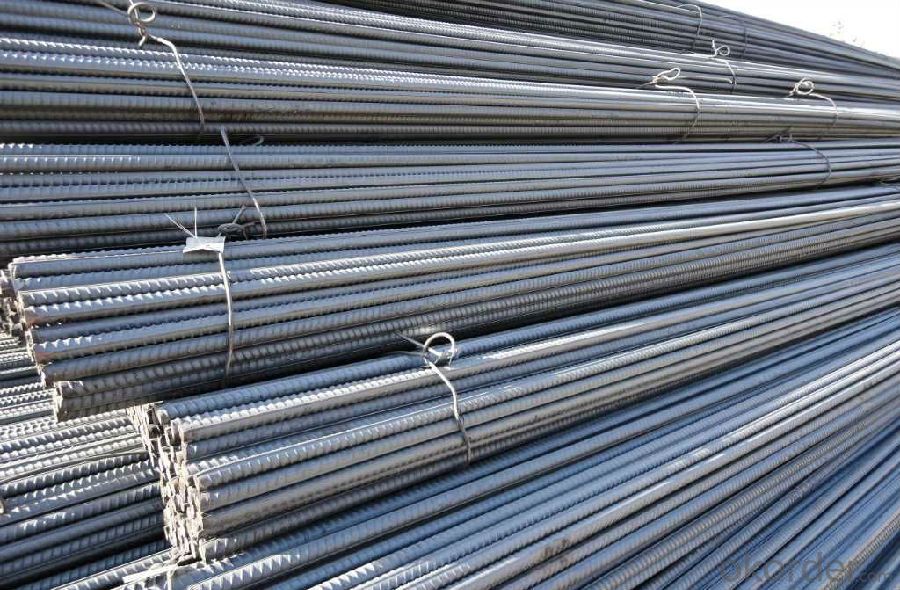
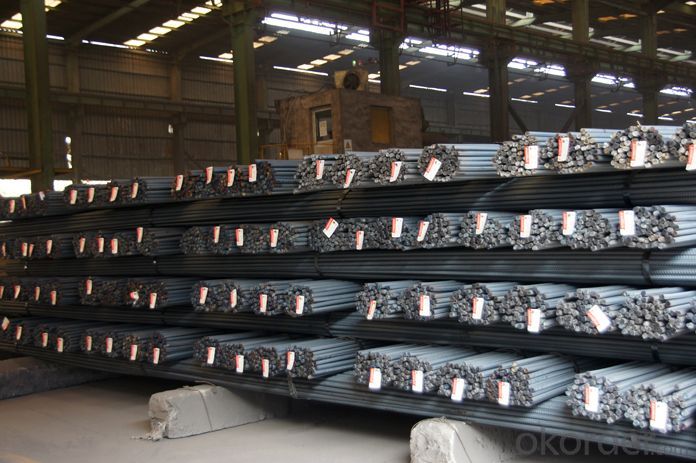
- Q: What are the common quality issues found in steel rebars?
- Some common quality issues found in steel rebars include insufficient strength or hardness, improper dimensions or shape, surface defects such as cracks or rust, and inadequate corrosion resistance. Other issues may include improper labeling or marking, poor welding or bonding properties, and inconsistent mechanical properties throughout the rebar.
- Q: What are the cost implications of using steel rebars in construction?
- The cost implications of using steel rebars in construction can vary depending on several factors. Firstly, the cost of steel rebars themselves will have an impact on the overall construction budget. The price of steel rebars can fluctuate due to factors such as global demand, availability of raw materials, and market conditions. Therefore, the cost of steel rebars can differ from one project to another. Secondly, the quantity of steel rebars required for a construction project will also affect the cost implications. The size, complexity, and load-bearing requirements of the structure will determine the amount of steel rebars needed. As a result, larger and more intricate projects will require a higher quantity of steel rebars, which can increase the overall construction costs. Moreover, the installation and labor costs associated with steel rebars should be considered. Experienced and skilled labor is required to properly install and secure the rebars in place, ensuring structural integrity. The cost of labor can vary depending on the location, availability of skilled workers, and project timeline. Additionally, the equipment and tools necessary for handling and cutting steel rebars may incur additional expenses. Furthermore, the longevity and durability of steel rebars can have long-term cost implications. Steel is known for its strength, resistance to corrosion, and ability to withstand harsh environmental conditions. By using steel rebars, structures can have a longer lifespan and require less maintenance and repairs over time. This can result in significant cost savings in terms of maintenance and replacement expenses. However, it is also important to consider potential cost implications related to sustainability and environmental impact. The production of steel rebars requires substantial energy and resources, which can contribute to carbon emissions and environmental degradation. In some cases, alternative construction materials or methods may be more cost-effective in terms of sustainability and long-term environmental considerations. In summary, the cost implications of using steel rebars in construction depend on factors such as the price of steel, quantity required, labor costs, installation expenses, and long-term durability. While steel rebars offer numerous benefits in terms of strength and longevity, it is crucial to consider the project's specific requirements and balance them with potential economic and sustainability considerations.
- Q: Can steel rebars be used in the construction of dams or reservoirs?
- Yes, steel rebars can be used in the construction of dams or reservoirs. Steel rebars are commonly used as reinforcement in concrete structures, including dams and reservoirs, to provide strength and stability. They help to distribute and resist the tensile forces that can occur in these structures due to water pressure and other external loads. Steel rebars are corrosion-resistant, durable, and have high tensile strength, making them an ideal choice for such applications. Additionally, they can be easily shaped and installed, providing flexibility in the design and construction process.
- Q: Can steel rebars be used in temporary structures?
- Yes, steel rebars can be used in temporary structures. They are commonly used to provide reinforcement and strength to temporary structures such as scaffolding, formwork, and temporary supports. Steel rebars have high tensile strength and can withstand heavy loads, making them suitable for temporary structures that require stability and durability.
- Q: What are the methods used for corrosion protection of steel rebars?
- There are several methods used for corrosion protection of steel rebars. 1. Coating: One common method is to apply a protective coating on the surface of the steel rebar. This coating acts as a barrier, preventing moisture and oxygen from reaching the steel surface and causing corrosion. Coatings can be applied using various techniques such as hot-dip galvanizing, epoxy coatings, or fusion-bonded epoxy coatings. 2. Cathodic Protection: Another method is cathodic protection, which involves the use of sacrificial anodes or impressed current systems. Sacrificial anodes are made of a more reactive metal (such as zinc or magnesium) that corrodes over time instead of the steel rebar. This ensures that the steel remains protected. Impressed current systems use an external power source to provide a protective current to the steel rebar, preventing corrosion. 3. Concrete cover: A simple but effective method is to provide a sufficient concrete cover over the steel rebar. The concrete acts as a physical barrier, shielding the steel from the environment. The thickness of the concrete cover is critical and should be designed according to specific standards to ensure adequate protection. 4. Inhibitors: Corrosion inhibitors can be added to the concrete mix or applied on the surface of the steel rebar. These inhibitors work by reducing the corrosive effects of moisture and oxygen on the steel surface. They can be organic or inorganic compounds that form a protective layer on the steel, inhibiting the corrosion process. 5. Proper design and construction practices: Lastly, proper design and construction practices can greatly contribute to corrosion protection. This includes avoiding the use of dissimilar metals that can cause galvanic corrosion, ensuring proper drainage to prevent water accumulation, and taking measures to minimize exposure to corrosive environments. It is important to note that a combination of these methods is often used to provide optimal corrosion protection for steel rebars, depending on the specific project requirements and environmental conditions.
- Q: Can steel rebars be used in seismic zones?
- Yes, steel rebars can be used in seismic zones. In fact, they are commonly used in construction projects located in areas prone to earthquakes. The high tensile strength and ductility of steel rebars make them an excellent choice for reinforcing concrete structures, ensuring their stability and resistance against seismic forces. Additionally, steel rebars can be designed and installed in a way that enhances the overall seismic performance of buildings and infrastructure.
- Q: Can steel rebars be used in the construction of offshore wind farms?
- Yes, steel rebars can be used in the construction of offshore wind farms. Steel rebars are commonly used in reinforced concrete structures, providing strength and durability. In offshore wind farms, where structures are exposed to harsh environmental conditions, steel rebars are essential for reinforcing foundations, substructures, and other concrete components. They help ensure the stability and integrity of the offshore wind farm structures, making steel rebars a vital material in their construction.
- Q: What are the common mistakes to avoid when handling and storing steel rebars?
- Some common mistakes to avoid when handling and storing steel rebars include: 1. Improper handling: Rebars should be lifted and moved using appropriate equipment such as cranes or forklifts. Attempting to handle them manually can lead to injuries and damage to the rebars. 2. Inadequate storage conditions: Rebars should be stored in a clean, dry, and well-ventilated area to prevent rusting and corrosion. Exposure to moisture or extreme temperatures can degrade the quality of the rebars. 3. Insufficient support: When storing rebars horizontally, they should be placed on a flat surface and adequately supported to prevent bending or deformation. Stacking them too high without proper support can result in damage and compromise their structural integrity. 4. Inadequate protection: Rebars should be protected from direct contact with the ground or other materials that may cause damage or contamination. Using pallets or other protective barriers can help prevent rust and ensure the rebars remain in good condition. 5. Neglecting regular inspections: Regularly inspecting the rebars for signs of damage, rust, or other defects is crucial. Any compromised rebars should be removed from use to ensure safety and structural reliability. By avoiding these common mistakes, the handling and storage of steel rebars can be done effectively, ensuring their quality and performance in construction projects.
- Q: What are the different types of steel rebars used in marine construction?
- The different types of steel rebars used in marine construction include epoxy-coated rebars, stainless steel rebars, and galvanized rebars. Epoxy-coated rebars are commonly used in marine environments due to their corrosion resistance properties. Stainless steel rebars are also used for their excellent corrosion resistance and strength. Galvanized rebars, which are coated with a layer of zinc, are another option for marine construction as they provide good protection against corrosion.
- Q: What is the process of inspecting steel rebars for quality control?
- To ensure that steel rebars meet the required standards and specifications, the quality control inspection process encompasses various steps. Below is a general outline of the process: 1. Visual Inspection: Initially, the rebars undergo visual inspection to identify any visible defects such as cracks, surface imperfections, or irregular shapes and sizes. This can be done manually or by utilizing automated systems that employ image processing techniques to detect defects. 2. Measurement and Dimensional Inspection: The dimensions of the rebars, including length, diameter, and shape, are measured using calibrated instruments such as calipers, gauges, or laser-based devices. These measurements are then compared to specified tolerances to ensure compliance. 3. Chemical Analysis: A sample of rebars is taken and subjected to chemical analysis to determine the steel's composition. This involves measuring the levels of carbon, manganese, sulfur, phosphorus, and other elements. The results are then compared to the required chemical composition specified in the standards. 4. Mechanical Testing: The mechanical properties of the rebars, such as tensile strength, yield strength, elongation, and bendability, are crucial for construction purposes. Samples are extracted from the batch and tested in a laboratory using standardized tests, such as tensile testing machines, to ensure they meet the specified requirements. 5. Corrosion Resistance Testing: Since rebars are often exposed to harsh environmental conditions, assessing their resistance to corrosion is essential. This can be achieved through tests like salt spray testing or electrochemical methods, which measure the rebars' corrosion resistance and ensure their long-term strength. 6. Weldability Testing: If the rebars are intended for welding applications, their ability to form a strong and defect-free weld joint is assessed. This includes evaluating their weldability through visual inspection, bend tests, or even destructive testing of welded samples. 7. Documentation and Certification: Throughout the inspection process, detailed records of measurements, test results, and observations are documented. If the rebars pass all quality control tests, a certification or quality control report is issued, confirming that they meet the required standards and specifications. It is important to note that the specific inspection procedures may vary depending on the applicable standards, project requirements, and the type of rebar being inspected. Furthermore, these inspections can be conducted by internal quality control teams or independent third-party inspection agencies to ensure impartiality and accuracy of the results.
Send your message to us
Deformed bars Hot Rolled with Material GB HRB400
- Loading Port:
- Tianjin
- Payment Terms:
- TT OR LC
- Min Order Qty:
- 25 m.t.
- Supply Capability:
- 10000 m.t./month
OKorder Service Pledge
OKorder Financial Service
Similar products
Hot products
Hot Searches
Related keywords



